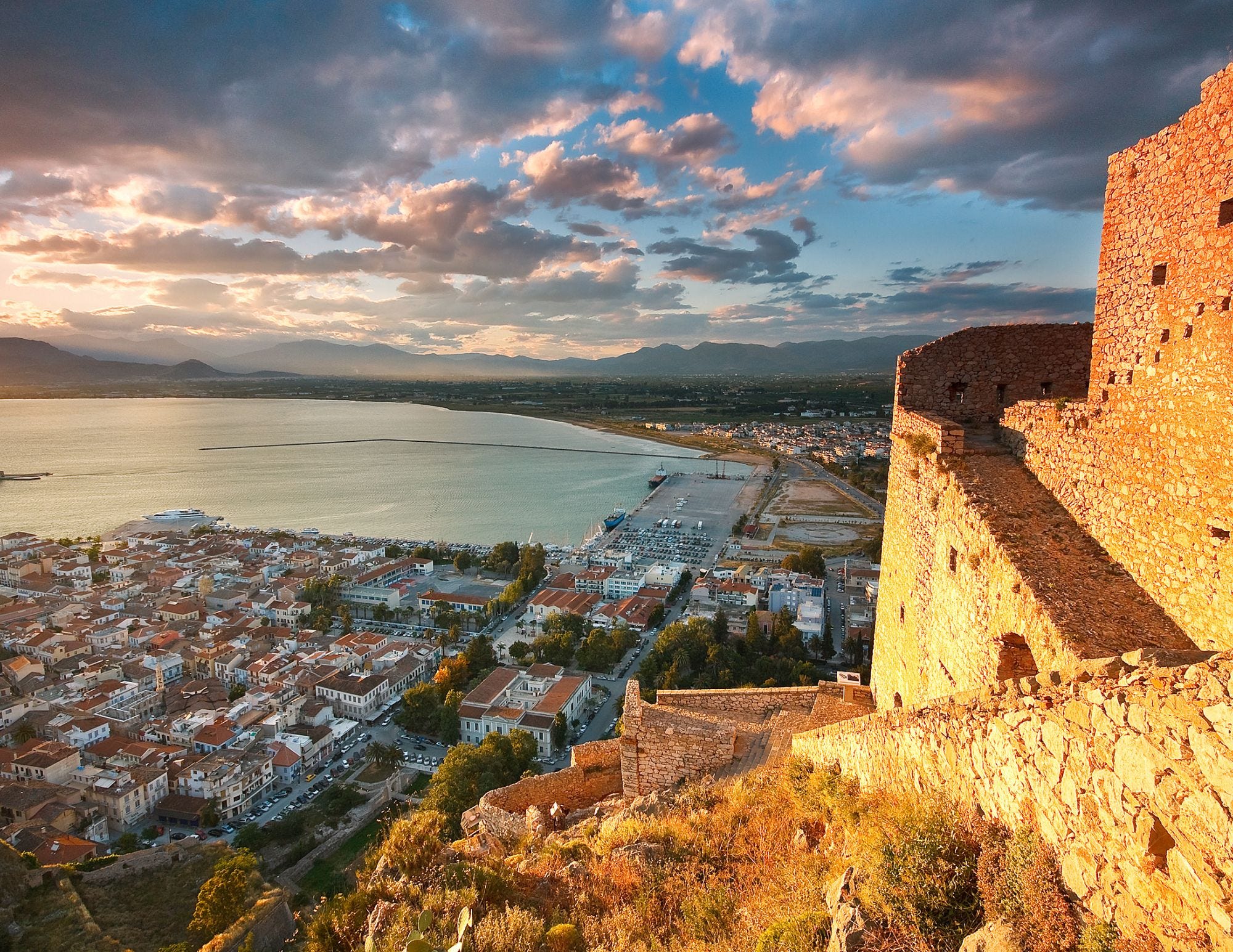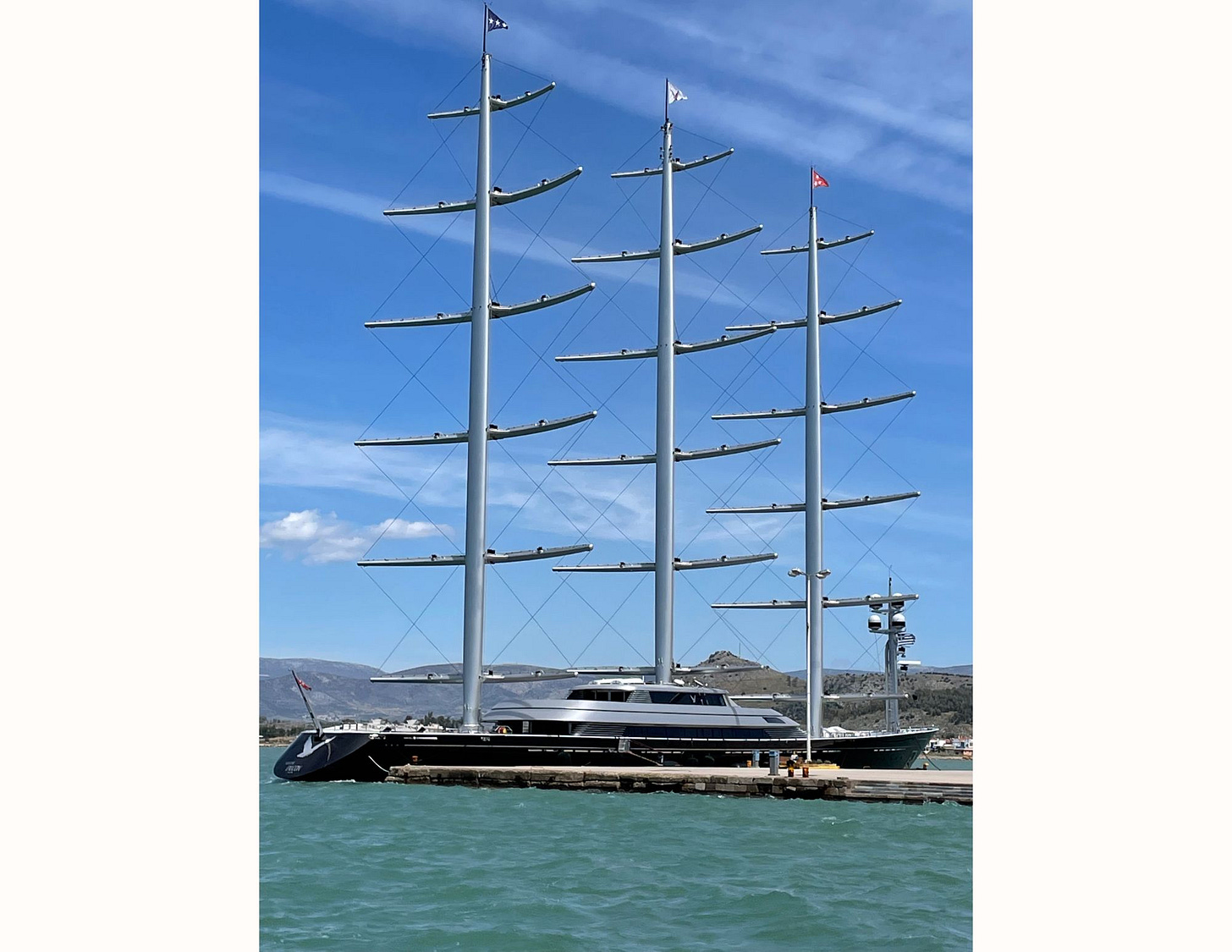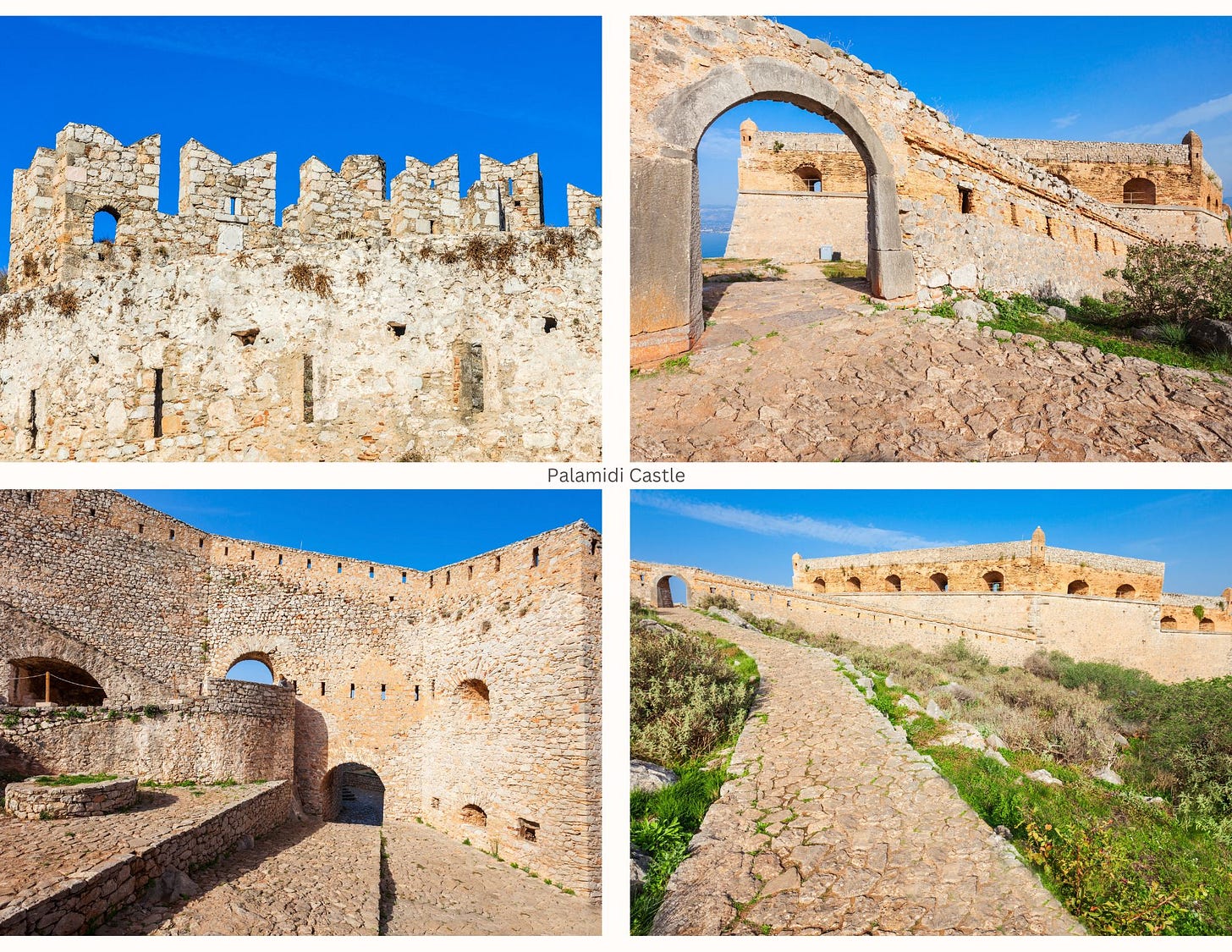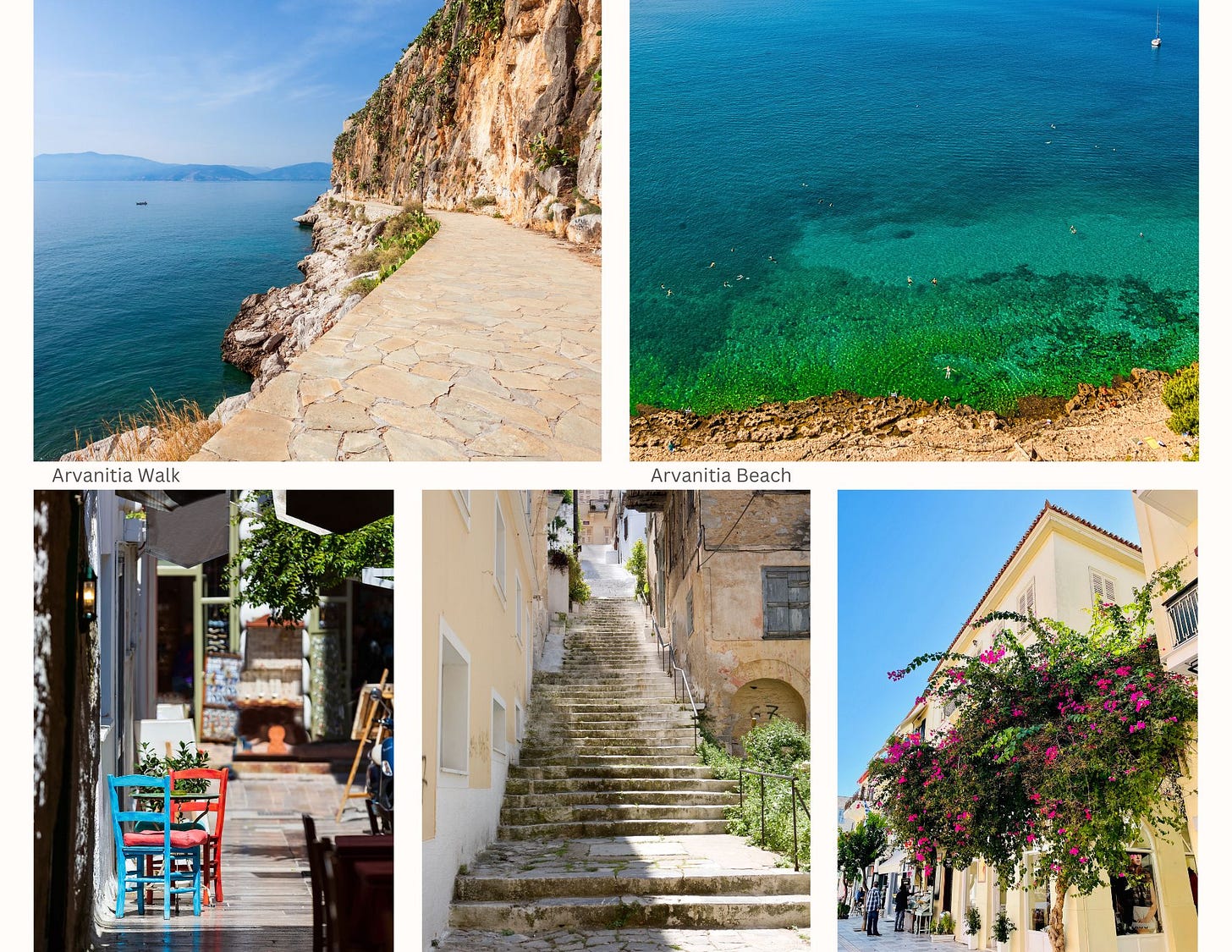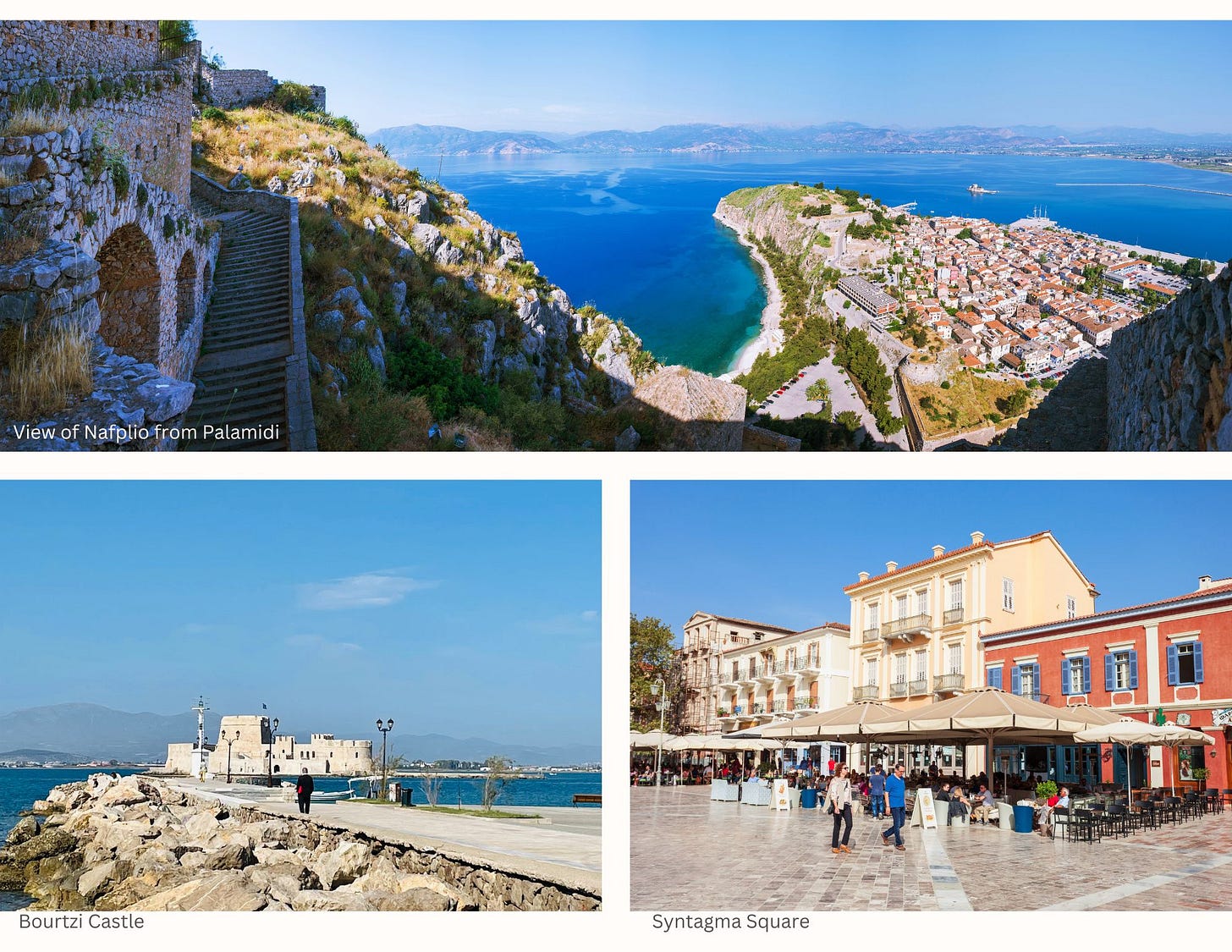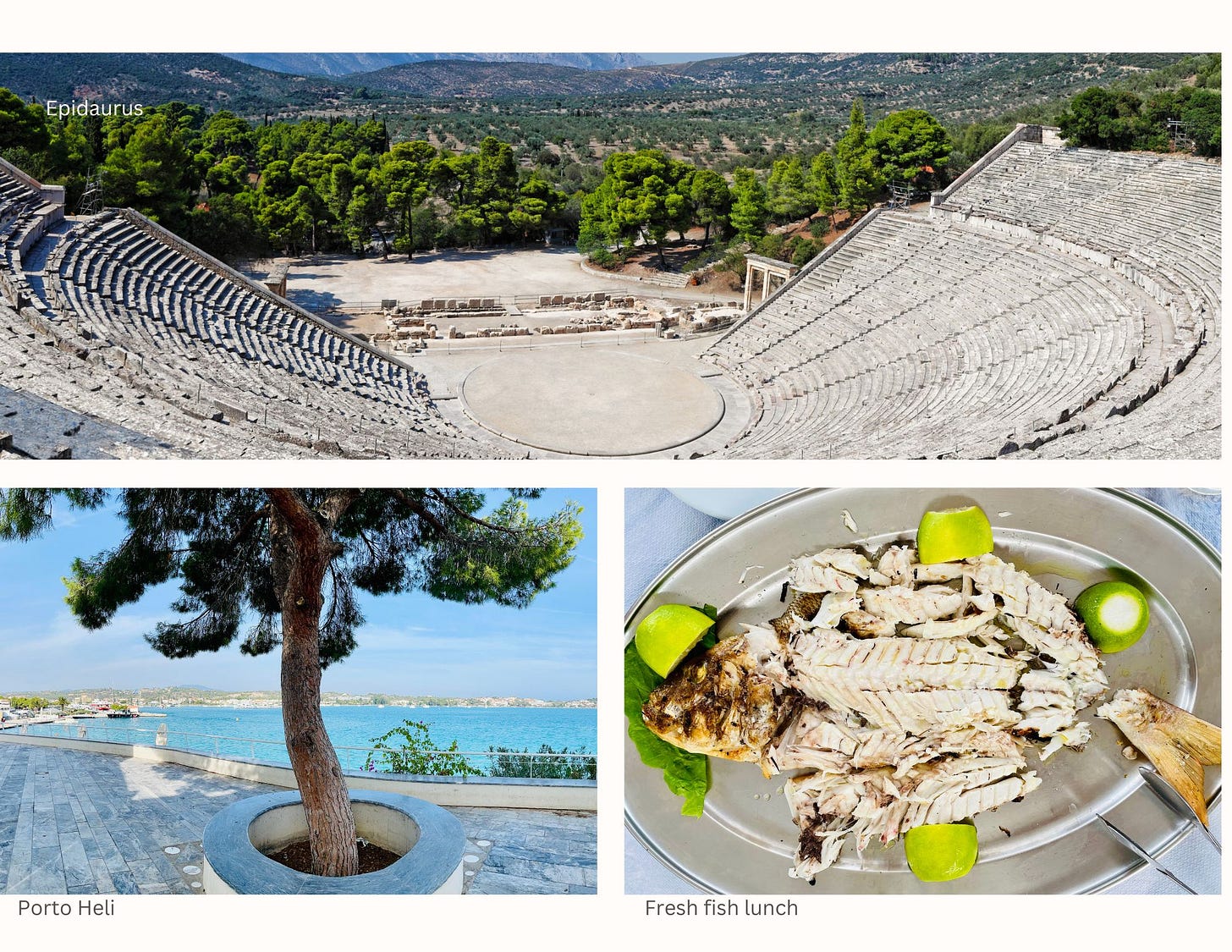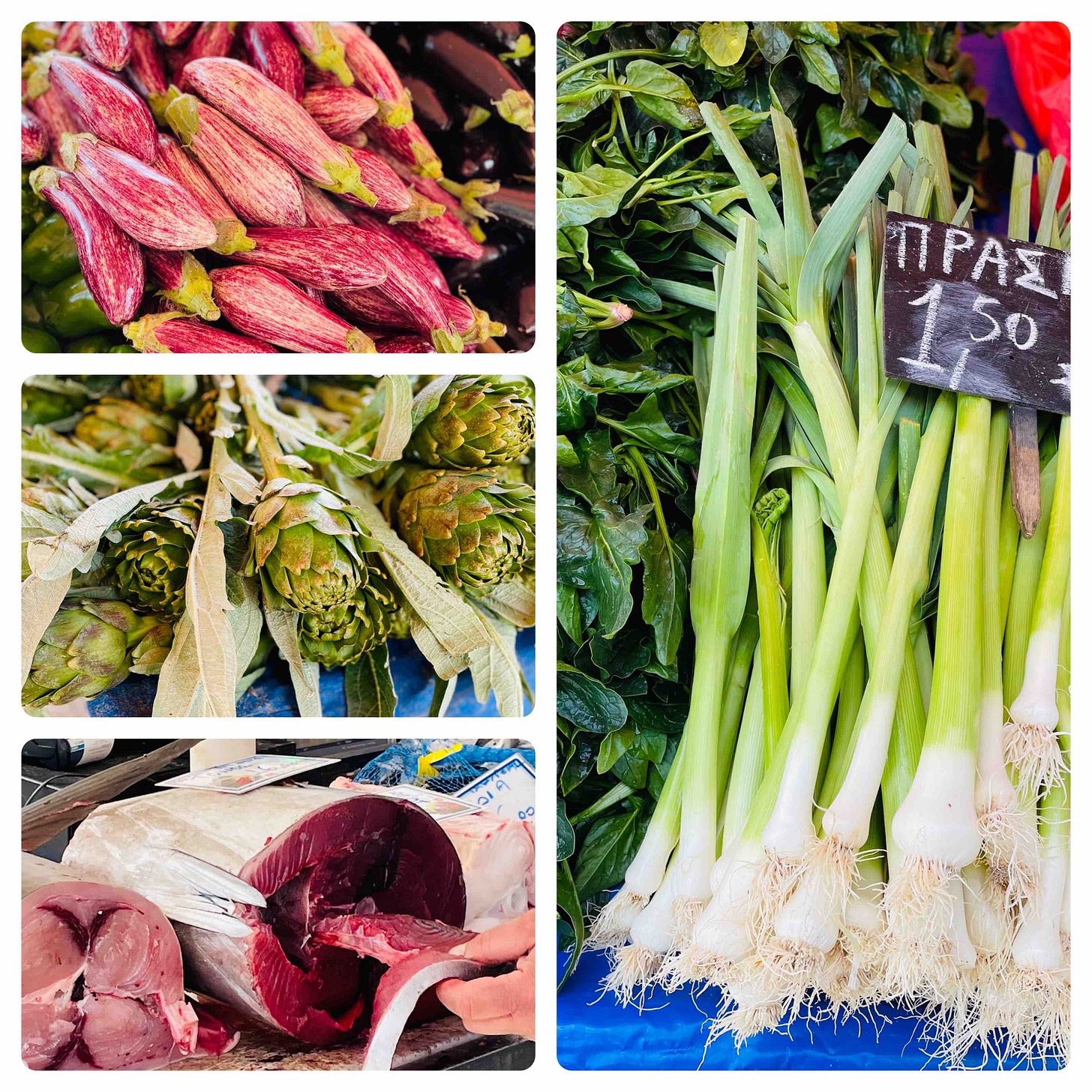Nafplio
This just might be the Greek gem you've been looking for. The hotels are stunning, the food fabulous and one of the best Airbnb's we've ever stayed at.
You’re receiving this email as a subscriber to A Voyagist Newsletter. Thank you!! If you know someone who may enjoy it, please pass it along!
When you have traveled as much as we have over the last 16 years, you are always on the lookout for the hidden gems, the places you don't hear much about. They don't have to be remote, just not the big names. They do have to inspire, and we found one.
Our trips to Athens have always been a stopping off place to the islands, especially Crete, which we love. But it was early November, and tourism on the islands was over. Not much open. My wife, Ellen, did some research and found the village of Nafplio, just a 2-hour drive up the coast and open year round. The town is named after Nafplios, the son of Poseidon. Known as the most romantic city in Greece, Nafplio is an ancient seaport fought over by everyone from the Byzantines to the Romans to the Venetians to the Ottomans. It was the first capital of Modern Greece in early 1828. The first President of Greece was Ioannis Kapodistrias, one of the great European politicians of his day; part of a group that actually created Switzerland. His Greek reign was short-lived as ongoing Ottoman issues resulted in his assassination on the steps of St. Spryridon church on a Sunday morning in 1831. The church is still there, and so is the first bullet embedded in the wall that missed. The second one didn’t miss.
The town is a beauty! There is just one main street in the old town, with double-wide sidewalks and several squares as you walk the car-free side streets. One side runs up to the base of the mountain, the other down to the port. Either way, there are great little shops and restaurants.
Our hotel, the 3Sixty, was once a private residence. Beautifully done with a great restaurant and bar in the center of Old Town. As it was the low season, they gave us our choice of suites, and we picked the one facing the harbor with the hot tub on the big terrace.
We saw a boat on our first walk two blocks to the harbor. Not just A boat, The Maltese Falcon was built by the Venture Capital guru Tom Perkins. I immediately knew it as I read Mine's Bigger about the boat and how Perkins built it. One of the most beautiful sailboats in the world, it is 289 feet long, sleeps 12 with a crew of 18, and charters for USD 500,000 a week. The unique sails are furled inside the three masts and can be released at the touch of a button. My cheque didn't clear.
Rising above the town is a mountain and the Fortress of Palimidi, actually, five forts surrounded by castle walls with breathtaking views over the town and out to sea. The town is charming, with great restaurants, perfect for walking, and only 15,000 people in Old and New Town. Old Town is historic, and New Town is where local people work and live. The port is active and will be full of cruise ships in summer, but it is quiet in November.
Tip: There are two main ways to get to the Palamidi fortress. You can go via the road (a taxi one way will cost about USD 10) or climb the 999 very steep steps up to the fortress; however, depending on who you believe, it's about 853 steps. The entrance fee is USD 8 during the high season (April-October) and USD 4 in the low season (November-March). We were accidentally there on Free Admission day - every 1st Sunday from November 1 - March 1.
The food in town is fantastic, leaning toward seafood but with incredible mushroom risotto with a round of goat cheese parked in the middle that we found at the 3Sixty. And, their magnificent breakfast yogurt with thick Greek honey and super sweet pomegranate seeds. Our routine included an after-dinner walk to Antica Gelato, which claims to be the only gelato shop (there are a few) that makes the stuff from the original Italian recipes.
Tip: Arvanitia Walk is touted as the local’s “favorite place for a stroll.” The lovely paved walkway hugs the Gulf of Argolis on one side and the steep face of the hill of Acronauplia on the other. It begins next to the lighthouse and ends after about a kilometer at Arvanitia Square next to Arvanitia beach. The beach is pebbles, no sand, but, you can carry on the path to a sandy beach named Karathona, a local favourite.
Tip: Up the road from Arvanitias square, you can hike up to the Acronafplia ruins for the beautiful views of the city, the bay, and Arvanitia beach. You will pass by an abandoned hotel. Xenia Palace was built in 1961 by the Greek government as part of a nationwide attempt to boost tourism. Many high-class hotels were built around the country, near archaeological sites and other tourist attractions, much like the Paradores in Spain. In Spain, it works, but this Greek effort clearly didn't make the cut.
Nafplio Promenade is a picturesque seafront walk. There are many cafes and restaurants to enjoy the views of the sea and Bourtzi castle in the bay. Built in 1471 to protect the town from pirates, it became the residence for the executioner of prisoners from Palamidi and where he did his work. After that, a hotel and now the Nafplio Summer Music Festival venue. We liked the last bar/restaurant at the very end of the harbor next to the lighthouse. Perfect for people-watching with a cold Mythos beer.
There is a War Museum on the main street, just before Syntagma Square. A small, 4-floor building manned by a soldier at the entrance. As I mentioned, everyone has invaded Nafplio over the centuries, and each floor displays the battles and occupations, starting with the oldest. On the top floor, it closes with the German occupation of 1941. The only audiovisual in the place is one of the German atrocities in Athens. I had no idea how bad it was for the Athenians who were liberated in 1944. The whole place is more about history than war, that is, until the 4th-floor video.
Epidaurus
Around Nafplio are two important ancient sites - the Temple of Mycenae and Epidaurus and they are just a few miles away. On the advice of the Staikos Car Rental guy, we skipped Mycenae ("just a pile of rocks," he said) and headed straight for Epidaurus, which in ancient times was a healing center. As usual, conquered by just about everybody, it is known now primarily for its theater which was built in the 4th century BC and then expanded by 21 rows by the Roman occupiers. The acoustics are remarkable, allowing actors to speak in normal tones and be heard in all 14,000 seats. Part of this is the limestone seating which filters out low-frequency sounds, and the fact the actors of the time were experts at projecting their voices. We didn't try it, as the place was too peaceful for a couple of tourists to yell at each other.
Porto Heli
From Epidaurus, we drove south to Porto Heli on a gorgeous, twisty road lined with orange and lemon groves. Porto Heli is supposed to be the Greek Riviera, where the ultra-rich have their walled villas, and the biggest issue is finding chefs for their private parties. It is a lovely little bay with one main street lined with sidewalks and dockside cafes; most are closed as the season is still weeks away. The Amanzoe, rumored to be the most expensive hotel in Europe, is closed until April. There wasn't much to see, but we did stop at a dockside restaurant before taking the 2-hour drive back to Nafplio. Pretty standard until we saw the owner walk to the dock to greet a boat and put fresh fish in a bucket. He picked one for us and grilled it. I'm not much of a fish guy, but it was irresistible. Ellen says it was overdone, and I will take her word for it.
In summary, Porto Heli was not for us. Maybe the ultra-rich make it more interesting in season (like St. Tropez), but we were happy pulling back into Nafplio. The drive to Porto Heli is beautiful, but the town not so much.
And that was Greece 2021. Old friends and new discoveries. We shall return.
(Visited November 4-9, 2021)
Nafplio Redux
We have made multiple visits to many places; Bali, Italy, and France come to mind. Our second visit to Nafplio in less than a year confirms what we found the first time. It is a great little place, and we were very happy to see it again. A different season this time, the Greek islands were largely not open to tourists yet in early April, but Nafplio is year-round. Taking a comfortable Peugeot van for the 90-minute drive from Athens, we stopped again at the man-made Corinth Canal, where they were training their bungee jump instructors from their perch right below the main bridge. I think I would do it, but it was not yet open. The Canal is over 6 km long, essentially hand-dug in several attempts since the 1st Century AD. It is at sea level and connects the Ionian Sea with the Aegean Sea. Bankruptcies, landslides, and various false starts plagued the construction until its completion in 1893. Today, given it is only 24 meters wide, it is too narrow for modern ships, and the 90-meter-high vertical walls channel winds making it a problem for pleasure craft. Still, it is fantastic to see, even if you aren't of the bungee persuasion.
Tip: The Archeological museum in Syntagma Square Nafplio is worth a visit to see its crowning glory, the Mycenaean bronze armour with boar tusk helmet. It is the only complete set of armor ever found for this early Mycenaean period.
The Airbnb we picked in Nafplio was an absolute gem. Christos and his wife have taken great care to fit out this spacious, second-floor suite right on the border between the old town and the new town. Best Airbnb we have EVER rented. Two fantastic bedrooms with ensuites, terraces front and back, totally equipped kitchen. Christos even put in a Nespresso machine he brought in for us from Athens.
In the harbor, the infamous Maltese Falcon boat is still there from last year, so I assume this is its home port. Once again, my cheque bounced. USD 500,000 a week to charter this beautiful thing seemed almost reasonable (almost). This time we learned the farmers’ market is held every Wednesday and Saturday just two short blocks from our Airbnb. We LOVE farmers’ markets, and this one is fantastic. The produce is all gigantic, and the wild honey is from local hives. Freshly caught tuna sliced as thick or thin as you want, plus all manner of spices and dried fruits. Not to be missed.
Nemea
Again we were stunned by the enormous salads every restaurant serves and the excellent local wine. We did a wine tasting at Karonis Distillery Exhibition and Shop ( open for 130 years ) and then, in a rental car, drove up to the wineries of Nemea, only an hour away. One winery was enough; the Pavilou Estates red called Nohma is a stunner. Pavilou is known for its reds but for white wine nearby Mantineia has some crisp and aromatic whites. Our wine tasting was followed by lunch nearby at Sofos. Our Greek foodie friend recommended it; "world-class food, probably the best in the Peloponnese, and the meat dishes are extraordinary, as is the wine." Indeed, it is well worth the drive.
Tolo
Finally, we drove to the beach resort of Tolo, an old fishing village with a history dating back to Homer. Quiet as they were prepping for the season opening, but a great lunch on the beach.
Nafplio did not disappoint; exploring the surrounding area, the ancient ruins, the wine region, and the coastal towns made it even better. It was the Greek gem we'd been searching for.
(Visited April 1 - 8, 2022)




